5 Ultracontemporary Artists Redefining the Korean Art Landscape
The dynamic South Korean art scene is quickly becoming one of the most prominent globally, blending rich traditions with cutting-edge innovation. And...
Carlotta Mazzoli 13 January 2025
2 December 2024 min Read
The subject of artificial intelligence is present in many contemporary debates: science, education, politics, etc. And, of course, art is not going to be left out of these conversations. Creativity is undergoing a moment of change, and it is important to stop and reflect on how this technology affects the arts. Unveil some of these mysteries with the help of artworks created by artificial intelligence and artists who help us understand its uses and challenges.
The programs that can be used to create art through artificial intelligence are not only popular but also used outside of the artistic community. One of the most frightening issues for the artists’ community is the fear of becoming dispensable. For some time now, we’ve been inundated with news about AI creating artworks that question the creative capacity of the human being. Truth be told, this is nothing but the long-standing debate of authorship, linked to creativity and artistic genius, which joins the very human fear of being replaced by machines.
However, it is important to highlight and celebrate the role of many contemporary artists who use AI to create artworks. Many of them play an essential role in learning to navigate a technology that advances at a dizzying speed. In fact, if there is one thing that art has always been good at, it’s taking an existing tool and pushing its limits by making it do things for which it was not designed.
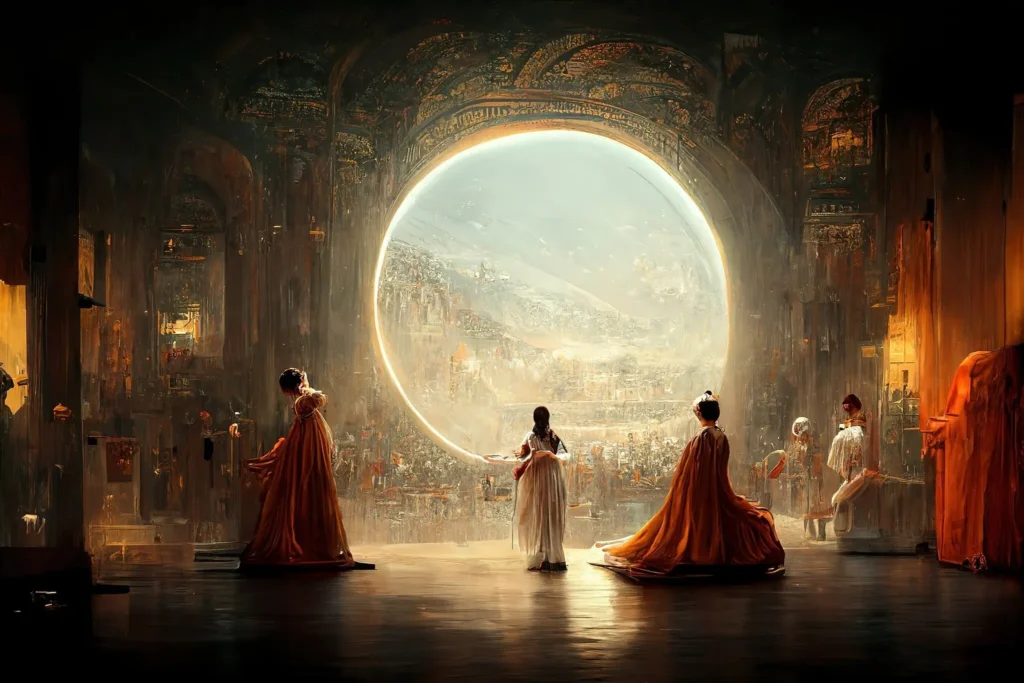
Jason Allen’s AI-generated work Théâtre D’opéra Spatial (2022) took first place in the digital category at the Colorado State Fair. New York Times.
The first artist on this list has a piece that can help us understand how AI perceives and interprets the world (or more accurately, “tries to make sense of what it is seeing”). Memo Akten is a multi-disciplinary artist, musician, and researcher from Istanbul, Turkey, currently based in Los Angeles. He creates Speculative Simulations and Data Dramatizations investigating human-machine entanglements, exploring perception, consciousness, ecology, technology, and spirituality. He has been working with artificial intelligence, Big Data, and Collective Consciousness for over a decade now.
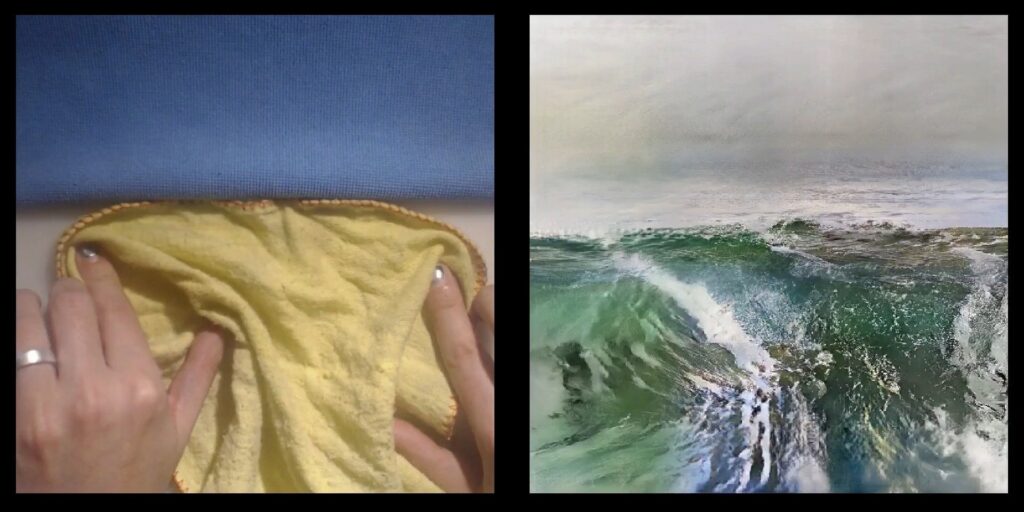
Memo Akten, still from Learning to See, 2017. Onassis.
In the Learning to See series (2017–), Memo Akten harnesses the latest machine-learning algorithms to explore how humans interpret the world. At the core of this series lies a compelling inquiry: how difficult is it to truly understand the world from someone else’s perspective? In Learning to See: Gloomy Sunday, Akten unveils a video and interactive installation. Here, live camera recordings of a table adorned with objects are meticulously analyzed by neural networks trained on diverse datasets, spanning oceans, fire, clouds, and flowers. This innovative project prompts viewers to ponder the intricacies of perception and the evolving relationship between humanity and technology.
Memo Akten, Learning to See: Gloomy Sunday, 2018. Vimeo.Ar
Because we too, see things not as they are, but as we are.
Now that we know how AI sees, let’s discover an artist who reveals what AI dreams about… Refik Anadol is one of the most well-known artists worldwide who works with artificial intelligence. His site-specific audio/visual performances have been featured at iconic landmarks, museums, and festivals worldwide such as the Museum of Modern Art in New York or Casa Batlló in Barcelona. Refik Anadol has been fascinated by this technology for years, and his interest lies in using it in unexpected ways. He utilizes data as his primary medium, transforming it into visual narratives across various forms. Through his work he explores the challenges and possibilities posed by ubiquitous computing and AI on humanity.

Refik Anadol, Artificial Realities: Coral, 2023, Davos, Switzerland. Artist’s website.
In an AI image generator, the user must request which image they want to create, providing a text that describes it as accurately as possible. Then, artificial intelligence algorithms begin the creation process following those parameters and using a series of images as patterns or references. However, this has never been truly inspiring for Refik Anadol: “To me, what was more inspiring is what happens if you don’t use a technology as it’s imposed on us, but use it differently.” In most of his pieces, there’s no intention to mimic reality, but, as the artist says, “It is trying to dream and speculate an imagination of a machine.”
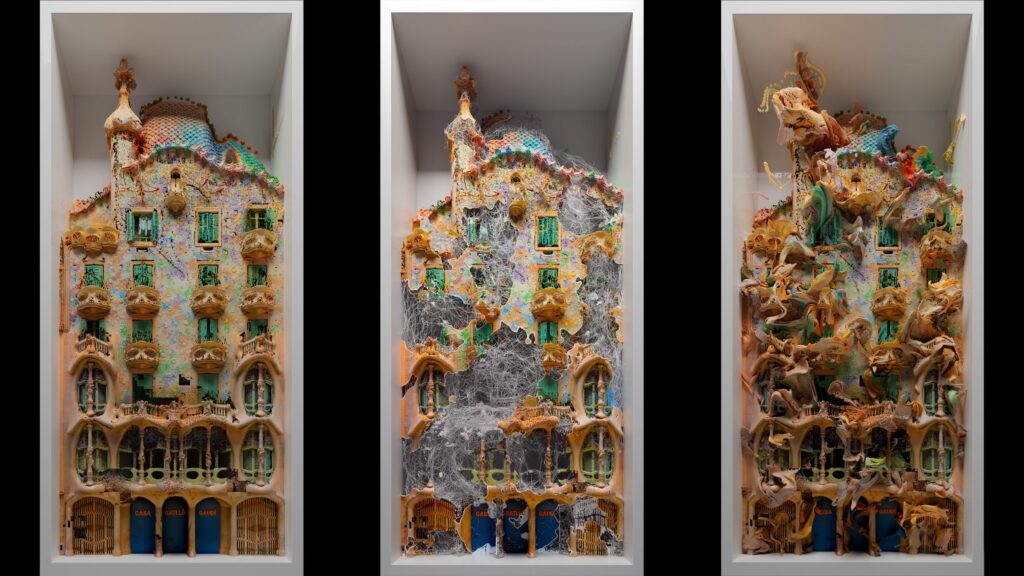
Refik Anadol, still from Living Architecture: Casa Batlló, 2022, Barcelona, Spain. Artist’s website.
One example of this is the giant AI Data Sculpture Nature Dreams presented at König Galerie, Berlin, Germany in 2021. This piece utilizes 300 million photographs of nature to generate pigments, shapes, and patterns that we would normally associate with nature. However, these images only exist in the mind of the machine as dreams. The result is a hypnotic installation that completely engulfs the observer in this AI reverie, which, in a way, answers the question posed by the classic novel by Philip K. Dick: Do Androids Dream of Electric Sheep?
Refik Anadol, Machine Hallucinations: Nature Dreams, 2021, König Galerie, Berlin, Germany. Photographed by Roman März.
Mónica Rikić is a Barcelona-based electronic artist and creative coder. Her work explores alternative technologies, merging technology and philosophy through art. She focuses on creative coding and electronics, often integrating non-digital objects for interactive projects, robotic installations, and handmade electronic devices.
One of her most recent works, which has been installed in the hall of the iconic Apolo Club in Barcelona, is Psychoflage. This colorful installation is composed of electronic air modules that inflate and deflate in response to an AI system detecting changes in the room’s airflow caused by its occupants. The result is a magnetic display of light, psychedelia, and fantasy, offering a warm welcome to clubbers as they step into the club and dance to the rhythm of their own movements.
Mónica Rikić, Psychoflage, 2023, Art Meets Apolo, Apolo & LAB 36 Gallery, Barcelona, Spain.
Anna Ridler is a British artist and researcher focusing on knowledge systems and technology’s role in understanding the world. She has a deep interest in measurement, quantification, and their links to the natural world, aspects widely reflected in her aesthetics. While often working with datasets to craft unique narratives, she uses machine learning to explore memory, the creator’s role, degeneration, and ontology, often revealing new associations and expectations to this technology.
One of her especially beautiful works is Mosaic Virus, a piece that again uses machine learning to reflect on aspects that go beyond the uses of AI. It is an installation of AI-generated videos where three tulips appear on three screens, always in continuous evolution. To understand this work, it is necessary to know a previous one: Myriad (Tulips), where Anna reflects on the agency of the human being in the collection and the cataloging of data.
During a residency in Utrecht, Netherlands, Anna had the opportunity to coincide with the tulip season. She took a myriad of over 10 thousand digital photos of these individual flowers, which she used to create her own dataset of tulips. Visually, the piece embodies aesthetics within art research that delves into cataloging and archiving. It presents individual photographs of each of these flowers, with the meticulously annotating by hand of the color, size, and shape of the tulip.
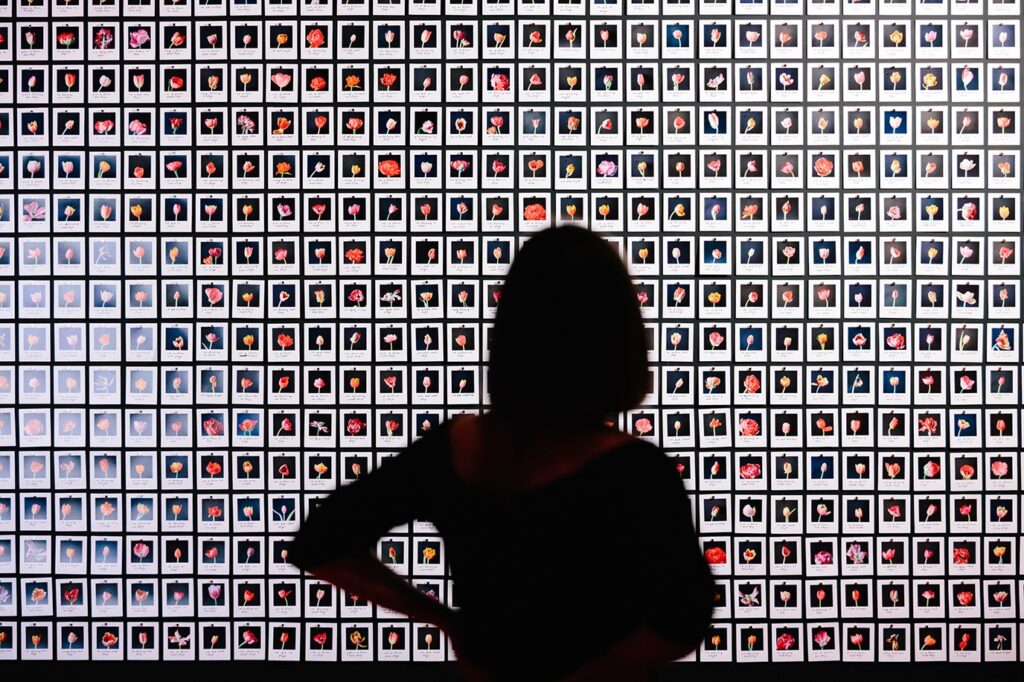
Anna Ridler, Myriad (Tulips), 2018. Artist’s website.
From these photographs, Mosaic Virus is created, where AI modifies the appearance of the tulips based on changes in the price of bitcoin. With this gesture, and establishing historical parallels with the Tulipmania of the 17th century, Mosaic Virus represents the hysteria and speculation surrounding cryptocurrencies today while also reflecting on the art market, where a work is only “valuable” once it becomes scarce. Thus, as the price of bitcoin rises, the tulips become more streaked, as these were considered more valuable at the height of Tulipmania.
Anna Ridler, Mosaic Virus, 2019. Artist’s website.
Pilar Rosado, a biology graduate with a PhD in fine arts, is a multifaceted artist, educator, and researcher from Barcelona, Spain. In her artistic practice, Rosado explores socio-political themes and challenges conventional perspectives, leveraging machine learning technologies to address issues such as information management in future visual archives, the reevaluation of collective memory, and the nuances of artificial creativity. Her innovative approach pushes the boundaries of traditional art-making, offering fresh insights into the evolving relationship between humans, art, and technology.
One of her recent works presented at the Panoràmic Festival in Barcelona is Miratges. In this dual installation, the viewer is immersed in a universe generated by deep learning algorithms. On the screen, distorted human faces merging with landscapes are projected, creating amalgamated, dystopian, and disturbing images. This speculative piece demonstrates how artificial creativity can expand an individuals’ imaginative capacities. Pilar Rosado seeks to showcase how art and technology merge to create new and revealing possibilities.
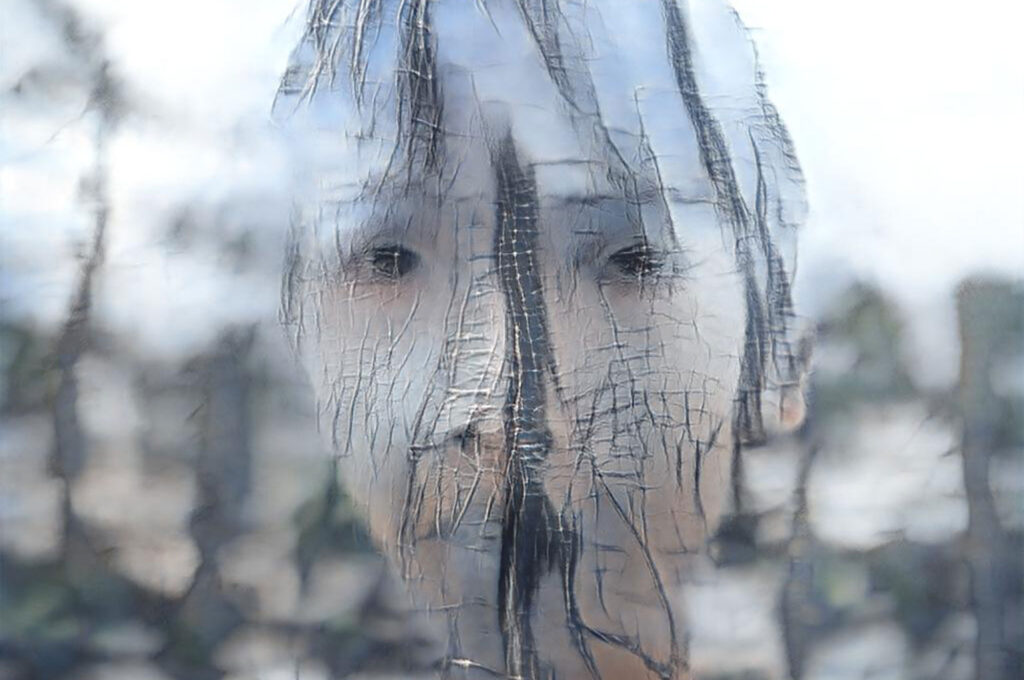
Pilar Rosado, Miratges, 2023. Nuvol.
Joan Fontcuberta, one of Spain’s most internationally acclaimed photographers, is renowned for his groundbreaking post-photographic theory and has been honored with numerous awards. His body of work has consistently navigated themes of memory, truth, and the relationship between nature and culture, challenging conventional notions associated with photographic imagery. In fact, his visual universe intricately weaves together the concepts of truth and fiction, maintaining an ongoing dialogue marked by ambiguity. He is characterized by dry humor, sharp wit, and impeccable technique, all together challenging authority and veracity across various domains, including science, technology, art, and politics.
Before delving into one of his most recent creations, where the artist utilizes artificial intelligence as an ally, it is worth exploring his previous creative universe to draw a parallel. In 1983, the Catalan artist presented Herbarium, a work that exposed the mechanisms through which images are treated as truth, particularly in scientific contexts, despite their lack of veracity. By dismantling the conventional associations between image, truth, and science, Joan Fontcuberta emulated Karl Blossfeldt’s systematic approach, constructing a universe of unknown vegetation created from diverse materials such as industrial or plastic remnants, bones, and fragments of plants or animals. Acting akin to a genetic designer, he crafted these species of artificial nature.
Moreover, to heighten the deception, the images of these fake plants were accompanied by erudite-looking texts, further complicating the viewer’s perception. Thus, Fontcuberta’s work presents an ironic and aesthetically pleasing deception, yet it always contains subtle dissonant elements that ultimately unveil the artist’s own deceit… Just look at the names of the flowers! Something seems definitely off.
When it comes to AI, Joan Fontcuberta is keen on utilizing this tool to challenge our perception of the world. In a venture reminiscent of Herbarium, Fontcuberta unveiled the series De Rerum Natura in 2023. Here, viewers are met with black-and-white photographs that evoke a natural reverie—a collection of mushrooms and flowers set within an especially atmospheric landscape. However, peculiarities soon emerge within the photographs: unidentifiable plants and mushrooms (reminiscent of Alice in Wonderland) alongside impossible perspectives and blurs, sparking intrigue.
These images, once again a variety of unknown vegetation, provoke questions about the power of the image as a truth generator. What initially appears as a photograph ultimately reveals itself to be a carefully crafted deception courtesy of AI. Ultimately, these visual contrivances stem from the vast sea of existing images that the AI system cannibalizes to generate new ones. Both of Fontcuberta’s works, characterized by irony and playfulness, aid in exploring the categorical assumptions associated with photographic imagery and, now, with AI.
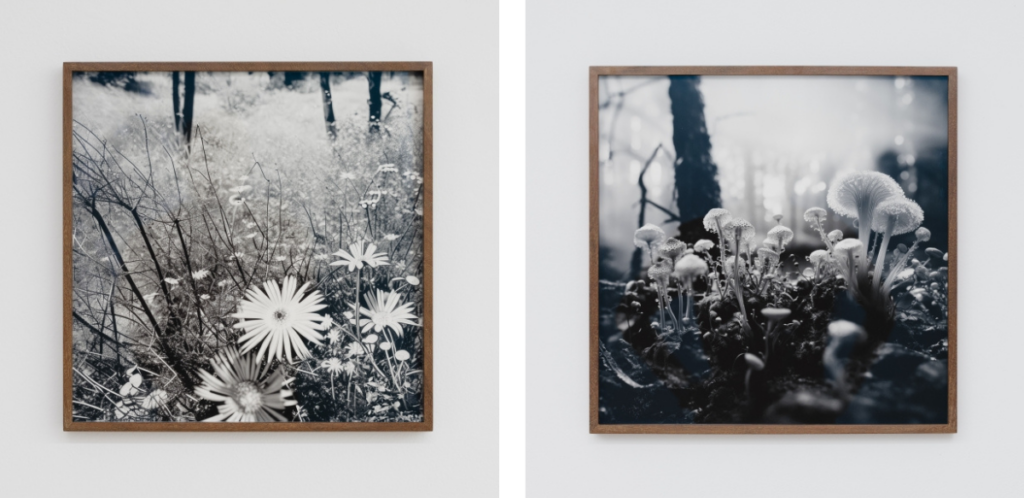
Joan Fontcuberta, De rerum natura: Floracrista etheralis (left), Fungus viridis (right), 2023. àngels barcelona.
These two Catalan artists are now working closely together on projects where they continue to speculate about the current and future challenges of image-making through AI. One of their collaborative works is La Petite Mort, where they have endeavored to artificially reproduce the expression of someone experiencing an orgasm. With this intimate gesture and by placing the viewer in the position of voyeurs imposed by screens, the artists aim to explore the limits of how human expressions can be captured. After training, the GAN (generative adversarial network) they utilized to create this piece generates artificial portraits.
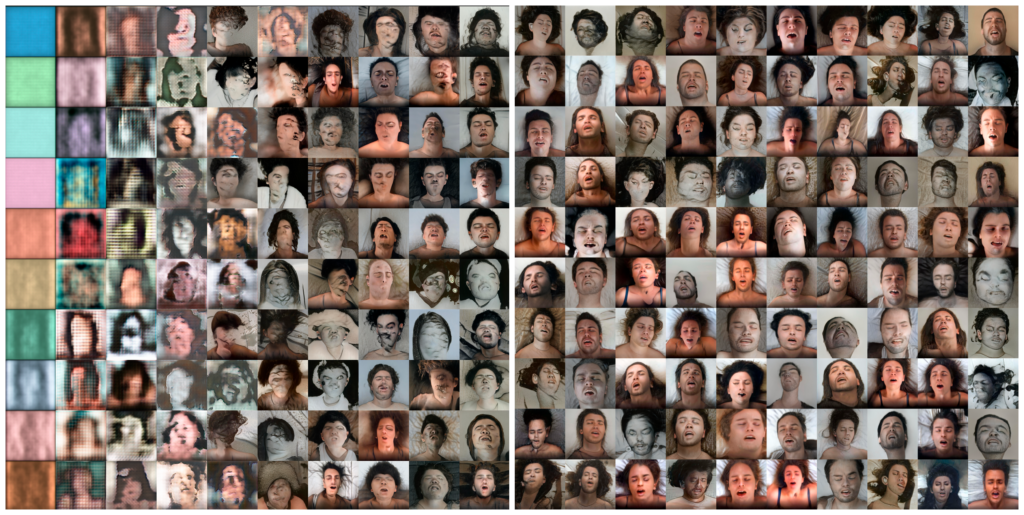
Pilar Rosado and Joan Fontcuberta, La Petite Mort, 2021. Prosopagnosia Project.
We find ourselves at a particular moment in history where AI is still being defined and explored. AI has not yet reached its full potential, and in fact, many artworks that reflect this technology do so by addressing its errors. Of course, there are understandable fears about the present and future uses of AI, but the challenge is to make it a tool in service of a better future.
Memo Akten, Learning to See Series (2017-), artist’s website. Accessed 22 Apr 2024.
AI Art: How artists are using and confronting machine learning, Museum of Modern Art, New York City, NY, USA, 2023, YouTube. Accessed 22 Apr 2024.
DailyArt Magazine needs your support. Every contribution, however big or small, is very valuable for our future. Thanks to it, we will be able to sustain and grow the Magazine. Thank you for your help!